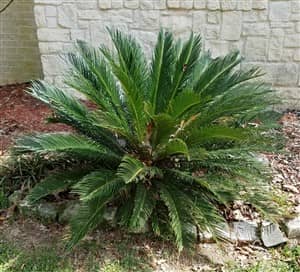The Boxer that Survived Sago Palm Poisoning
Meet Lady...

Lady is a 3 year old Boxer dog owned by Sharon and Bobby Laughlin of Village Mills, Texas.
At the age of 1 year old, this Boxer was playing in the yard one moment, and in serious trouble the next. What happened caused repercussions still being treated to this day.
This Boxer dog's amazing story of survival is a wise reminder for all Boxer owners. While many dangers are obvious, some are just not widely-known. Until it is too late.
The one that relates to Lady is plant poisoning. This beautiful Boxer ingested some pieces of a Sago plant. Life for Sharon, Bobby, and Lady changed forever from that point on.
Here, we'll learn just how dangerous Sago palms are to dogs, exactly what happened, the treatment that she needed to survive, and her ongoing health issues that are being carefully managed by her loving owners.
-min-192x360-1920w.jpg)
The Sago palm is considered a tropical plant, which grows naturally in tropical and subtropical environments such as New Guinea and Malaysia.
In the US and some other countries, this is both an ornamental houseplant and can be found among landscaping in just about every state.
In some overseas countries it is a food source. Sago is extracted from the stem, ground into a flour-like substance, and used in a variety of foods including baked goods and breads.
But, this plant is dangerous:
- The seeds of this plant are highly toxic to both humans and animals. In Guam, there were outbreaks of Parkinson's disease-like disorders that were linked to the ingestion of the plant's seeds.
- And most importantly, ALL parts of the Sago palm are highly poisonous to dogs and cats. It contains a neurotoxin called cycasin, which causes severe liver failure.
Survival rate for dogs that ingest Sago palm is only 50%.
And this number includes dogs that receive immediate, emergency care.
With 15 minutes to 3 hours of ingesting any part of the plant, there will be gastrointestinal distress. This includes drooling, vomiting, and/or diarrhea.
Within 2 to 3 days, the central nervous system is affected. Damage to the liver can be almost immediate and within 2 to 3 days severe and often fatal liver failure can be seen.
Lady's Story - Surviving Plant Poisoning
-min-300x428-1920w.jpg)
Here, you'll read the story of what happened and how this Boxer is doing today, written by Lady's owner Sharon.
Life for Lady
started December 1, 2012. It was a rough start. Her mother was in poor health and the caregiver was unable to provide health care for her nor the puppies.
Lady was the runt and fought for every inch of space. Once she was born her chance of survival was lost twice. Another breeder stepped up and took possession of the pups. The new caregivers named her Angel because she survived at all.
At 4 months of age and 3 pounds, I was able to take possession of this baby Boxer with the big brown eyes and the adorable under bite. The caregivers were unsure about selling this little girl. But once they were assured of our devotion to her care, our lives changed forever. My husband, recently retired, had a new job now.
Lady became her name because of my childhood Boxer mix breed. The name fit! She was easy to housebreak, learned commands early, and stayed at my feet, especially in the kitchen.
Then it all changed.
-min-340x293-1920w.jpg)
One afternoon, while playing in our back yard, I saw her chewing on a dead Sago palm branch. I had seen it before but she had such fun, I didn’t pay any attention. We had Sago palms everywhere, both in the front and back yard.
Then, I kept getting this uneasy feeling about it. She was only recently allowed to play alone in back yard. Wisely I called her vet.
After an overnight stay with the vet clinic and a lot of blood work, we received the unfortunate news.
Lady had Sago palm ingestion with ongoing hepatopathy: liver disease. Imagine how I felt. Perhaps I could have prevented this had I been more educated about Sago palms. That very week we dug up 10 full grown Sago palms.
Our lives really did change at this point. It was all about Lady now.
She was put on daily doses of Ursodiol and Denamarin. Liver monitoring was every three weeks along with regular blood work.
After a year of constant monitoring, we wanted to get more absolutes about her condition. Other than the bad blood work, Lady appeared to be a normal, active, playful Boxer. But we knew she was not well.
in April 2015 we took Lady to Gulf Coast Veterinary Specialists in Houston, Texas. After an examination along with a review of previous records, it was suggested that a liver biopsy be performed. This was done a week later.
Results disclosed high copper levels in liver and that’s not good. Our objective was to medicate and do all we could to keep copper buildup from the liver. Lady weighed 67 pounds at this time.
At first we put her on liver diet dog food from the vet. After several months and $77 a case (which she ate in a week), I decided we should try something else. So, I located recipes for preparing food at home and began cooking her food every 3 days. She loves it.
Along with what the doctors told me, I did hours of research myself. Lady loved duck jerky. Guess what?
Duck causes copper in liver. She should not have bananas either. Bitter greens are good to detoxify the liver (humans as well). Other things not to feed her or any Boxer include rawhide, onions, grapes...
While in Houston another dog lover there told us of a case where their dog died just drinking water from the pan under a Sago patio plant. That is severe!
Now its March 2017. Lady weighs 72 lbs. She only needs to take one tablet in the morning (denamarin) for her liver.
She may have to take this for life, but it's a small price to pay. As often as possible I give her treats made from vegetables. No bones, cooked is bad but she doesn’t do well with uncooked either.
As of today, her bad liver count has improved 70%.
Recipe for “Organ Based Meal”
Please note: AllBoxerInfo is reader-supported. Some of the product suggestions on this page are affiliate links. As an Amazon Associate we earn from qualifying purchases. This is at no extra cost to you and helps keep this site running.
• 4 cups of organ meat (one or more of hearts, liver or kidney chicken meat). I use hearts and liver. To help costs I order hearts by the case from my butcher.
• 4 ground egg shells (just shells for calcium) finely ground. I use a martar.
• ½ cup cooked pasta (small shells work good)
• cup steamed carrots (sliced)
• ½ cup steamed broccoli (broken into small pieces) the broccoli stalk just as good to use.
• 1 cooked potato (cut in pieces)
• Vitamins added one meal per day (I use Wiz Pet All Natural Dog Food Supplement , which I order from Amazon)
, which I order from Amazon)
Directions are to cook the meat and then add rest of ingredients.
Use your own method to prepare; but after trial and error, I boil the meat in a quart of water until done then add veggies and cook 15-20 minutes (until slightly soft). I keep my veggies chunky. Turn off the fire and immediately add pasta shells, mixing well. Stir several times keeping pasta submerged as much as possible. Pasta is cooked within 20 minutes. Once the food is cooled, I then add the egg shells. Shells stick to food better when cooled.
Upon researching this condition I found out that 3 meals daily is best. This keeps the liver from working as hard.
Hope this helps keep your adorable pets healthy.
Sharon Laughlin
Village Mills, Texas (the Big Thicket)
ABI:
Thank you Sharon for sharing this story. Many owners probably did not know how dangerous Sago plants are. We're so happy to see that Lady is doing so well; she's a really awesome Boxer.
Keeping Your Boxer Dog Safe
This was certainly a sobering story of how a Boxer can almost die just from investigating things in the yard.
Pretty much everyone knows the most common toxins (chocolate, insecticides, fruit seeds, etc.). But, to keep your Boxer safe from this sort of thing happening, there are a few things to keep in mind:
1. Know that there are over 1000 plants and flowers that are poisonous to dogs.
The top 12 are: Autumn Crocus, Zazlea, Cyclamen, Kalanchoe, Lilies, Oleander, Diieffenbachia, Daffodils, Lily of the Valley, Sago Palms, Tulips, Hyacinths.
2. With 1000+ toxic plants, any number of which could be in your yard, don't let a Boxer be outside by himself.
It's just not worth it. Even if your Boxer has never chewed on plants before, it can happen. Dogs don't chomp on plants because they're hungry or if the plant tastes good. They do it out of curiosity and boredom.
3. Know the signs of toxic poisoning.
Sharon was smart to call the vet before symptoms even started. That may be what saved her Boxer dog's life. But, even if you don't see anything happen, never hesitate to seek immediate help if your Boxer has:
Excess drooling
Confused behavior
Signs of dizziness
Lethargy
Vomiting
Diarrhea
Swollen abdomen
Sigsns of abdominal pain
Jaundice
Black-tarry stools
Want to Read More Stories About Amazing Boxer Dogs?
Check out Boxer Dog Profiles
- A list of interesting articles about awesome Boxers and their owners. From those that survived harrowing ordeals, to those that do special training, you'll find it here.
Looking for Advice and Care Tips?
Supplies for a Boxer Dog
- A list of what's needed to provide optimal care for your Boxer puppy, adult, or senior dog.
Boxer Dog Skin Issues
- Common problems that can plague this breed, signs of more serious red flags, and remedies for dry skin and other issues.
Boxer Dog Head Bobbing
- See which type of head shaking is normal and which is a sign of a serious health issue.
The Boxer Dog Skinny Phase
- It's not uncommon for adolescent Boxers to having trouble keeping up their weight. Advice on how to safely help give your Boxer a bit of a boost.











